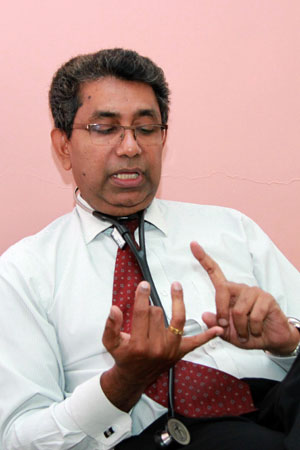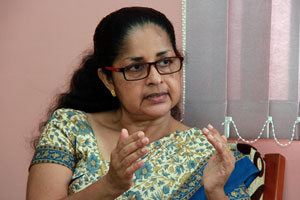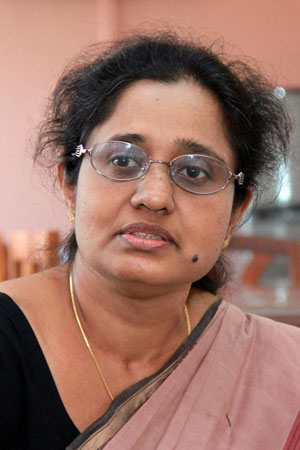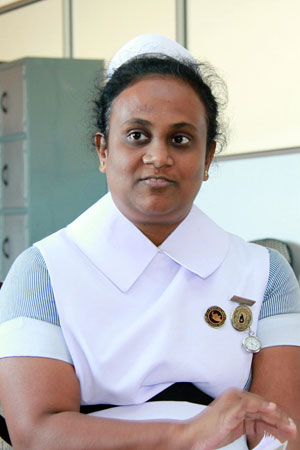Another life-saving medical chapter takes its first steps

Dr. Prasad Abeysinghe
Sri Lankan doctors at the National Cancer Institute in Maharagama (NCIM) working with the National Blood Transfusion Service and the Ministry of Health have become the first in this country to successfully complete a procedure known as stem cell mobilisation, a critical step leading up to another big milestone – the first autologous stem cell transplant to be conducted in a local public hospital.
It has taken the tightly knit, multi-disciplinary team at the NCIM, now also known as Apeksha Hospital many months and the support of multiple stakeholders to come to this point. Close partnerships with St. Vincent’s Hospital in Australia allowed the 16-member team to gain hands -on experience abroad and the partnership is ongoing as the newly established Bone Marrow Transplantation Programme gears up for its first year.
The first to benefit is a 48-year-old mother of two from Kochikade who was diagnosed with multiple myeloma eight months ago. A form of cancer, multiple myeloma causes cancer cells to accumulate in bone marrow, where they compromise the functioning of healthy blood cells and produce abnormal proteins that can adversely impact kidney function. Cancer is now the third most common cause of death in Sri Lanka. “Most patients with malignant bone marrow diseases will succumb if not treated properly. The impact of having a transplant for them is huge, it is a new lease on life,” says Dr. Prasad Abeysinghe, Consultant Oncologist and the BMT Team Leader at NCIM.
Doctors have spent days working closely with their patient, as she has undergone the gruelling process that could save her life and return her to her family. Dr.Abeysinghe tells the Sunday Times that various teams have been involved every step of the way: The clinical team is headed by Dr.Abeysinghe himself, while Consultant Haematologist Dr.Sasikala Suresh leads the haematology group, Consultant Microbiologist Dr. Samanmalee Gunasekare leads the infection control group and Consultant Transfusion Physician, Dr. Lakmali Morawaka leads the stem cell collection group. They have had to work in close concert to ensure the success of the programme.
Dr. Suresh explains that currently many patients requiring bone marrow transplants typically go abroad, where costs can be as high as $40,000 for the time-consuming procedure. Dr. Abeysinghe adds that since the process is such a long and demanding one, a patient’s best interests may not be served by going abroad as the logistics of long term care are harder to work out. Instead, Sri Lankans can now find treatment at NCIM, where the procedure has been designed in keeping with international standards.
When the stem cells being inserted belong to the patient themselves, the process is known as an autologous transplant. However, the more complicated procedure is when a donor’s stem cells are used, and that is known as an allogenic bone marrow transplant.
“There are three ways of collecting stem cells,” says Dr.Morawaka, explaining that the cells can either be extracted from the bone marrow or from ‘cord blood’, i.e where blood from placenta or the umbilical cord of a newborn is used as a source of stem cells. In Sri Lanka, the private sector offers only what is known as direct bone marrow extraction, where the cells are taken from the marrow itself through a syringe.

Dr. Lakmali Morawaka
The third option is what the team at Maharagama have set out to do, and is actually the recommended approach, say the doctors. In the process, known as peripheral stem cell collection, the cells are harvested from the blood using a special machine. In the days before, Dr. Suresh’s team uses medication to stimulate the production of stem cells. They then ‘mobilize’ these cells, stimulating them out of the bone marrow and into the bloodstream, from where they can be collected. Blood tests are then carried out to ensure there are enough cells circulating to justify the next step.
Under Dr.Morawaka’s team, the patient is hooked up to an apheresis machine – their blood is pumped through the machine, which separates out the stem cells before the blood is circulated back in to the patient’s body. The collected stem cells then have to be painstakingly processed to ensure they are viable and free of disease. If enough stem cells have not been collected, the process is repeated the next day. The cells must also be frozen to an exacting standard, so that they remain viable for years should the patient ever need them again.
The staff in the infection control groupare closely involved at every stage says D. Ayesha Nilanthi, Nurse, infection control. She and the team have to ensure that the patient remains free of infections that could prove life threatening – this includes responsibility for everything from deciding how antibiotics will be used to battle infection pre and post-transplant to maintaining the sterility of the collected samples in the long-term. Success is only possible by paying an extraordinary amount of attention to detail.
It’s no wonder then that the BMT team are now celebrating having finished their first stem cell mobilisation.The next and final stage involves using chemotherapy to destroy the malignant cells, after which the patient will be rescued with a transfusion of her own healthy bone marrow. She will require intensive supportive care for several weeks afterward while the new stem cells take root and begin to produce the platelets and red and white blood cells she needs to live. The full impact of the procedure is likely to be known only over a period of years.
With this initial success, the BMT team at NCIM have gained the confidence they need to tackle at least another 12 bone marrow transplants in the coming year. Haematological malignancies are common in children and young adults, and the team hopes that many young lives will be saved thanks to the new centre. They will also begin to take on more complex cases requiring donor stem cells. “There aren’t any shortcuts for bone transplant programme,” says DrAbeysinghe, saying it will take painstaking effort every step of the way.
For the team, this has been a fascinating and humbling process, in particular because it took the effort of so many people to bring them here. There were the challenges of venturing into a totally new field, and their gratitude to Prof. David Ma, and Associate Prof. John Moore and the rest of the team at St. Vincent’s is heartfelt. Scholarships supported by the Australian government and by local donors such as MAS and A.G.R. Samaraweera, Chairman of Maliban, allowed the entire team to travel. In Australia, the Sri Lankan community and in particular Jude and Chrishanthi Fernando, did a great deal to support the programme with awareness and fund raising.

Dr.Sasikala Suresh
On a personal level, the BMT programme has meant working weekends, late nights and time away from family for the entire team. Dr. Suresh says just mastering this new field has been challenging – though a significant portion of the training was hands on, it now continues over email and Skype, which for her is a new and interesting medium of learning.They hope the establishing of this centre will lead to others around the island, as more local doctors and clinicians are able to train with the team at Apeksha. Going forward, they hope to set up a bone marrow registry that will not only support Sri Lankans but those of Asian descent wherever they may be in the world.
The new facilities will be hosted inside the Razavi building adjoining NCIM which was donated by the Ahamad Tea Firm in London, with additional funding from the Ministry of Health. “It’s amazing to see it all coming together,” says Dr.Abeysinghe, “it would have been difficult for us to produce something like this overnight. It is truly state of the art, and in keeping with the way bone marrow transplant units are developed all over the world.”

Nurse Ayesha Nilanthi


